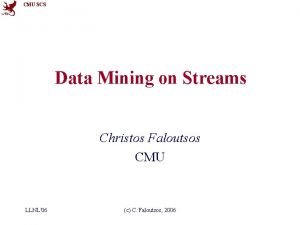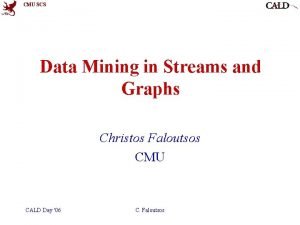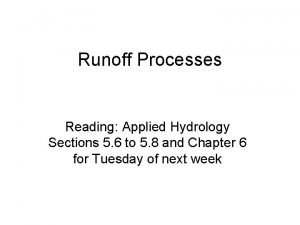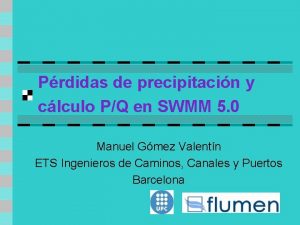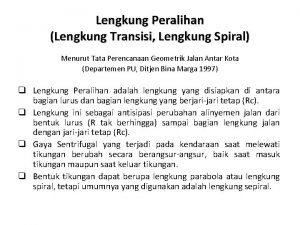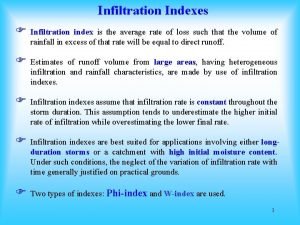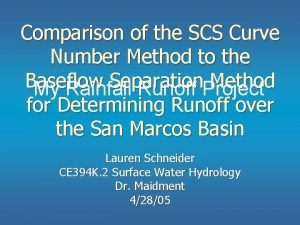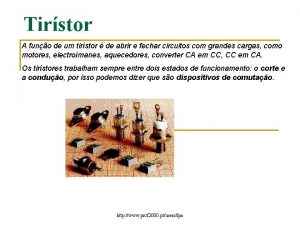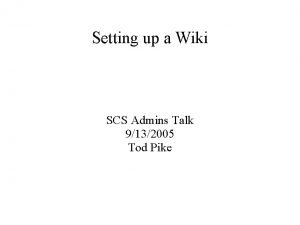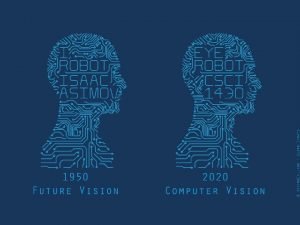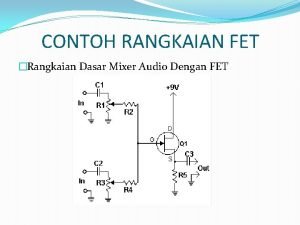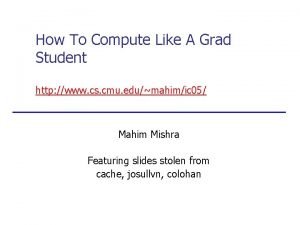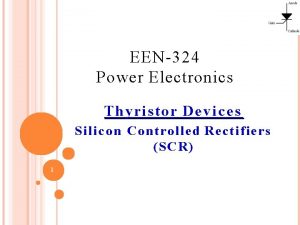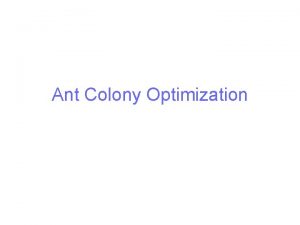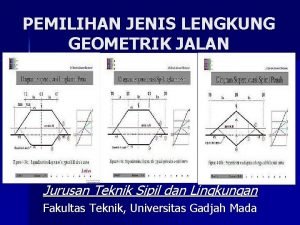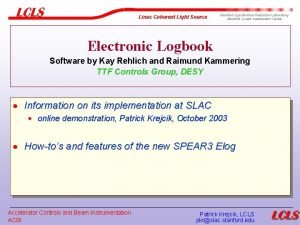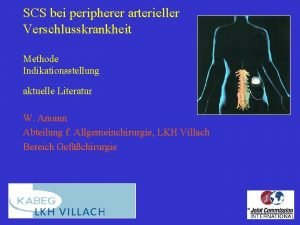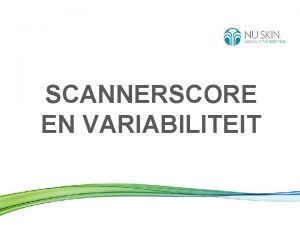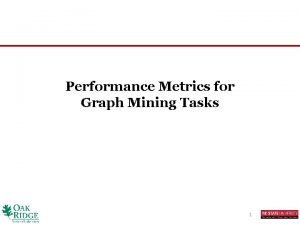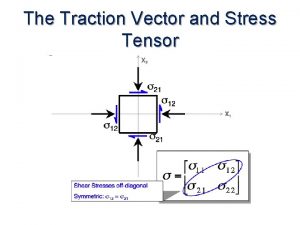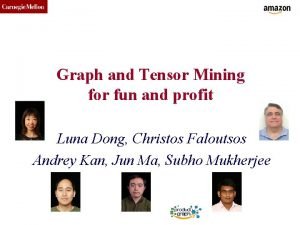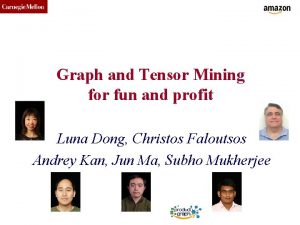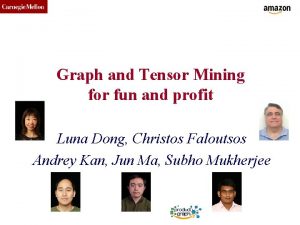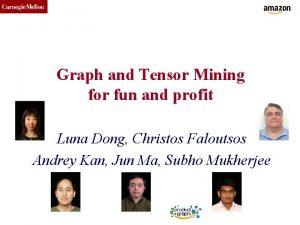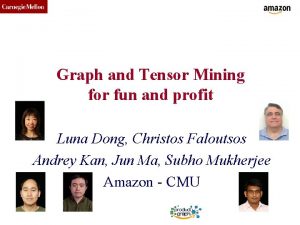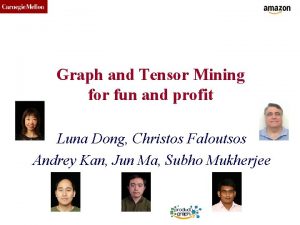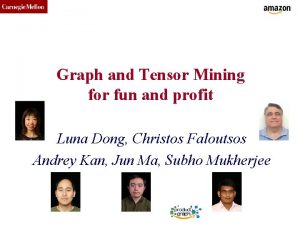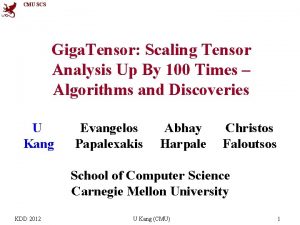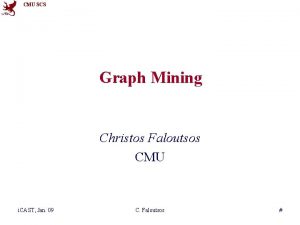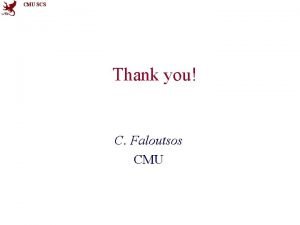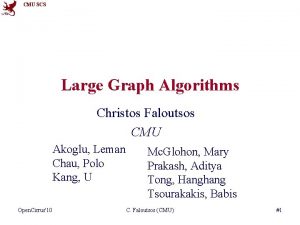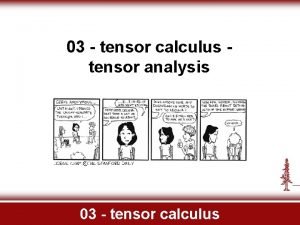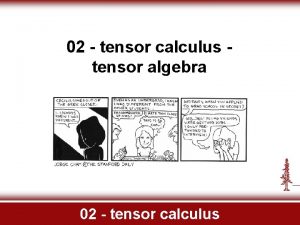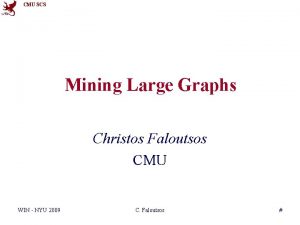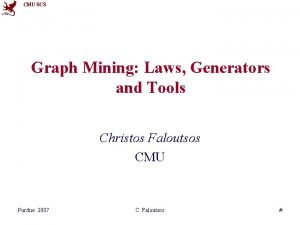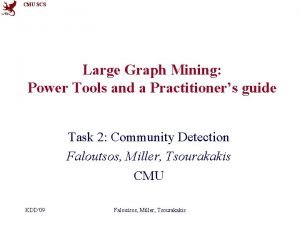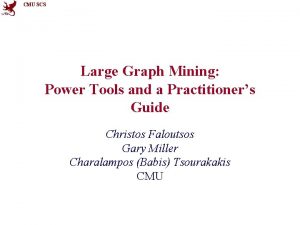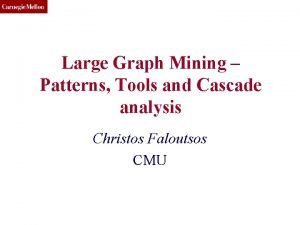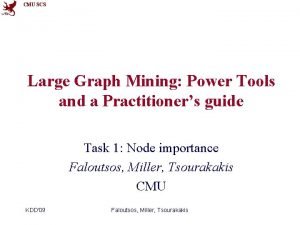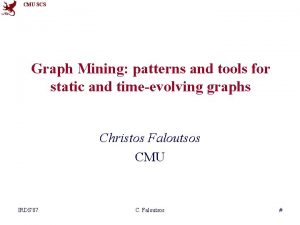CMU SCS Graph and Tensor Mining for fun




























































- Slides: 60

CMU SCS Graph and Tensor Mining for fun and profit Luna Dong, Christos Faloutsos Andrey Kan, Jun Ma, Subho Mukherjee

CMU SCS Roadmap • Introduction – Motivation • Part#1: Graphs • Part#2: Tensors – P 2. 1: Basics (dfn, PARAFAC) – P 2. 2: Embeddings & mining – P 2. 3: Inference • Conclusions KDD 2018 Dong+ 2

CMU SCS ‘Recipe’ Structure: • Problem definition • Short answer/solution • LONG answer – details • Conclusion/short-answer KDD 2018 Dong+ 3

CMU SCS Tensors, e. g. , Knowledge Graph • What is ‘normal’? Forecast? Spot errors? directed … dates … Acted_in born_in … KDD 2018 produced Dong+ 5

CMU SCS P 2. 2 - Problem: embedding? • Map entities, and predicates, to low-dim space(s) directed … dates … Acted_in born_in … KDD 2018 produced Dong+ 8

CMU SCS P 2. 2: Problem: embedding • Given entities & predicates, find mappings entity emb. directed … dates … Acted_in born_in produced KDD 2018 pred. emb. Dong+ 10

CMU SCS P 2. 2: Problem: embedding • Given entities & predicates, find mappings locations directed … dates … Acted_in artists born_in produced relations+ directed dates KDD 2018 Dong+ Acted_in Artistic-pred. 11

CMU SCS Short answer • S 1. Two potential relationships among sub (h), pred (r), and obj (t)? – Addition: h + r =? = t – Multiplication: h � r =? = t • S 2. Two loss function options – Closed-world assumption – Open-world assumption KDD 2018 Dong+ 12

CMU SCS Long Answer o Motivation o Graph Embedding o Tensor Embedding o Knowledge Graph Embedding KDD 2018 Dong+ 13

CMU SCS Long Answer Ø Motivation o Graph Embedding o Tensor Embedding o Knowledge Graph Embedding KDD 2018 Dong+ 14

CMU SCS Why embeddings (even for graphs)? KDD 2018 Dong+ 15

CMU SCS Why embeddings (even for graphs)? • Reason #1: easier to visualize / manipulate ? KDD 2018 Dong+ 16

CMU SCS Why embeddings (even for graphs)? • Reason #2: wild success of word 2 vec ‘queen’ = ‘king’ – ‘man’ + ‘woman’ Latent variable 2 (‘leadership’) KDD 2018 Latent variable 1 (‘collaborative’) Dong+ 17

CMU SCS Long Answer ü Motivation Ø Graph Embedding o Tensor Embedding o Knowledge Graph Embedding KDD 2018 Dong+ 18

CMU SCS Familiar embedding: SVD v 1 u 2 u 1 KDD 2018 v 2 Dong+ 19

CMU SCS Familiar embedding: SVD v 1 v 2 u 1 u 2 KDD 2018 Dong+ 20

CMU SCS SVD as embedding • A = U L VT - example: retrieval inf. lung brain data CS x = x MD KDD 2018 Dong+ P 1 -21

CMU SCS SVD as embedding • A = U L VT - example: retrieval CS-concept inf. lung MD-concept brain data CS x = x MD KDD 2018 Dong+ P 1 -22

CMU SCS SVD as embedding • A = U L VT - example: retrieval CS-concept inf. lung MD-concept brain data CS x = x MD KDD 2018 Dong+ P 1 -23

CMU SCS SVD as embedding retrieval inf. lung brain data CS x = x MD KDD 2018 Dong+ P 1 -24

CMU SCS Deep Graph Embeddings • • • Deep. Walk Node 2 Vec Metapath 2 Vec LINE Ultimate. Walk Auto. Encoder Struc 2 Vec Graph. SAGE GCN … KDD 2018 Skip-gram Dong+ 25

CMU SCS Skip-Gram • KDD 2018 Dong+ 26

CMU SCS Deep Graph Embeddings • • • Deep. Walk Node 2 Vec Metapath 2 Vec LINE Ultimate. Walk Auto. Encoder Struc 2 Vec Graph. SAGE GCN … KDD 2018 Skip-gram heterogenous graph 1 st order + 2 nd order proximity closed form, unifies Deep. Walk and Node 2 Vec reconstruct W, similar to SVD focuses on structural similarity “inductive”, sample and aggregate interesting! borrowed the idea from CNN Dong+ 27

CMU SCS Embedding can help with: • • • Reconstruction Fact checking (Node classification) (Link prediction) (Recommendation) … KDD 2018 Dong+ 28

CMU SCS Reconstruction of (2, 4) • retrieval inf. lung brain data ? CS x = x MD KDD 2018 Dong+ P 1 -29

CMU SCS Fact-Checking of (2, 4) • retrieval inf. lung brain data ? CS x = x MD KDD 2018 Dong+ P 1 -30

CMU SCS Long Answer ü Motivation ü Graph Embedding Ø Tensor Embedding o Knowledge Graph Embedding KDD 2018 Dong+ 31

CMU SCS Familiar embedding: SVD v 1 u 2 u 1 KDD 2018 v 2 Dong+ 32

CMU SCS PARAFAC: as embedding musicians athletes ve r b leaders subject + = + object KDD 2018 Dong+ 34

CMU SCS PARAFAC: as embedding musicians leaders athletes k: ‘leader’ i: ‘Merkel’ KDD 2018 + = j: ‘Germany’ Dong+ + 35

CMU SCS PARAFAC: as embedding musicians leaders athletes k: ‘leader’ i: ‘Merkel’ KDD 2018 + = j: ‘Germany’ Dong+ + 36

CMU SCS PARAFAC: as embedding • ‘Merkel’: i-th subject vector: (1, 0, 0) • ‘Germany’: j-th object vector: (1, 0, 0) • ‘is_leader’: k-th verb vector: (1, 0, 0) leaders musicians athletes k i + = KDD 2018 j Dong+ + 37

CMU SCS Reconstruction • leaders = KDD 2018 Dong+ musicians + athletes + 38

CMU SCS Reconstruction • leaders = KDD 2018 Dong+ musicians + athletes + 39

CMU SCS Reconstruction • leaders = KDD 2018 Dong+ musicians + athletes + 40

CMU SCS Long Answer ü Motivation ü Graph Embedding ü Tensor Embedding Ø Knowledge Graph Embedding KDD 2018 Dong+ 48

CMU SCS P 2. 2: Short answers • S 1. What is the relationship among sub (h), pred (r), and obj (t)? – Addition: h + r =? = t – Multiplication: h � r =? = t • S 2. What shall we optimize? – Closed-world assumption – Open-world assumption KDD 2018 Dong+ 49

CMU SCS S 1. Triple Scoring - Addition • Addition: h + r =? = t – Trans. E score(h, r, t) = -||h+r-t||1/2 KDD 2018 Dong+ 50

CMU SCS Trans. E KDD 2018 Dong+ 51

CMU SCS S 1. Triple Scoring - Addition • Addition: h + r =? = t – Trans. E score(h, r, t) = -||h+r-t||1/2 What if multiple objects apply? ? directed KDD 2018 Dong+ 52

CMU SCS S 1. Triple Scoring - Addition • Addition: h + r =? = t – Trans. E score(h, r, t) = -||h+r-t||1/2 – Trans. H: project to relationspecific hyperplanes KDD 2018 Dong+ 53

CMU SCS S 1. Triple Scoring - Addition • Addition: h + r =? = t – Trans. E score(h, r, t) = -||h+r-t||1/2 – Trans. H: project to relation-specific hyperplanes – Trans. R: translate to relation-specific space KDD 2018 Dong+ 54

CMU SCS S 1. Triple Scoring - Addition • Addition: h + r =? = t – Trans. E score(h, r, t) = -||h+r-t||1/2 – Trans. H: project to relation-specific hyperplanes – Trans. R: translate to relation-specific space – Many simplifications of Trans. H and Trans. R STrans. E is reported to be the best in Dat Quoc Nguyen. An overview of embedding models of entities and relationships for knowledge base completion. KDD 2018 Dong+ 55

CMU SCS S 1. Triple Scoring - Multiply • Multiplication: h � r =? = t – RESCAL: score(h, r, t) = h⏉Wrt Too many parameters!! KDD 2018 Dong+ 56

CMU SCS S 1. Triple Scoring - Multiply • Multiplication: h � r =? = t – RESCAL: score(h, r, t) = h⏉Wrt – Dist. Mult: score(h, r, t) = h⏉diag(r)t Simplify RESCAL by using a diagonal matrix KDD 2018 Dong+ 57

CMU SCS RESCAL Dist. Mult KDD 2018 Dong+ 58

CMU SCS S 1. Triple Scoring - Multiply • Multiplication: h � r =? = t – RESCAL: score(h, r, t) = h⏉Wrt – Dist. Mult: score(h, r, t) = h⏉diag(r)t Simplify RESCAL by using a diagonal matrix Cannot deal with asymmetric relations!! KDD 2018 Dong+ 59

CMU SCS S 1. Triple Scoring - Multiply • Multiplication: h � r =? = t – RESCAL: score(h, r, t) = h⏉Wrt – Dist. Mult: score(h, r, t) = h⏉diag(r)t Simplify RESCAL by using a diagonal matrix _ – Compl. Ex: score(h, r, t) = Re(h⏉diag(r)t) Extend Dist. Mult by introducing complex value embedding, so can handle asymmetric relations KDD 2018 Dong+ 60

CMU SCS Compl. EX • KDD 2018 Dong+ 61

CMU SCS Compl. EX • Dist. Mult Asymmetry KDD 2018 Dong+ 62

CMU SCS S 1. Triple Scoring - Multiply • Multiplication: h � r =? = t – RESCAL: score(h, r, t) = h⏉Wrt – Dist. Mult: score(h, r, t) = h⏉diag(r)t _ – Compl. Ex: score(h, r, t) = Re(h⏉diag(r)t) – Conv. E: Use convolutional NN to reduce paras KDD 2018 Dong+ 63

CMU SCS S 1. Triple Scoring - Multiply • Multiplication: h � r =? = t e v a h E v n o C d s t n l a u s x e E r l t p r a m o e C h t s f r e o t e e m t a sta duce par ibility – RESCAL: score(h, r, t) = h⏉Wrt – Dist. Mult: score(h, r, t) = h⏉diag(r)t _ – Compl. Ex: score(h, r, t) = Re(h⏉diag(r)t) – Conv. E: Use convolutional NN to reduce paras e x R e l f • n i a t r e C • KDD 2018 Dong+ 64

CMU SCS S 1. Triple Scoring - Multiply • Multiplication: h � r =? = t – RESCAL: score(h, r, t) = h⏉Wrt – Dist. Mult: score(h, r, t) = h⏉diag(r)t _ – Compl. Ex: score(h, r, t) = Re(h⏉diag(r)t) – Conv. E: Use convolutional NN to reduce paras , t h g i e w t h g i l. e s i c i t t l c u a r M t p s i n i D d o o g d n a KDD 2018 Dong+ 65

CMU SCS S 2. Loss Function • Closed world assumption: square loss KDD 2018 Dong+ 66

CMU SCS S 2. Loss Function • Closed world assumption: square loss • Open world assumption: triplet loss KDD 2018 Dong+ 67

CMU SCS S 2. Loss Function • Closed world assumption: square loss • Open world assumption: triplet loss k r wo A W O KDD 2018 t s e b s Dong+ 68

CMU SCS Embedding Applications • Learn embeddings from IMDb data and identify Wiki. Data errors, using Dist. Mult Subject Relation Target Reason The Moises Padilla Story written. By César Ámigo Aguilar Linkage error Bajrangi Bhaijaan written. By Yo Yo Honey Singh Wrong relationship Piste noire written. By Jalil Naciri Wrong relationship Enter the Ninja music. Composed. By Michael Lewis Linkage error The Secret Life of Words music. Composed. By Hal Hartley Cannot confirm … … KDD 2018 Dong+ 69

CMU SCS Long Answer ü Motivation ü Graph Embedding ü Tensor Embedding ü Knowledge Graph Embedding KDD 2018 Dong+ 70

CMU SCS Conclusion/Short answer • S 1. Two potential relationships among sub (h), pred (r), and obj (t)? – Addition: h + r =? = t – Multiplication: h � r =? = t • S 2. Two loss function options – Closed-world assumption – Open-world assumption KDD 2018 Dong+ 71

CMU SCS Conclusion/Short answer • S 1. Two potential relationships among sub (h), pred (r), and obj (t)? – Addition: h + r =? = t – Multiplication: h � r =? = t s t l u s re t r a • S 2. Two loss function options e h t l e f d o o – Closed-world assumption m e n t n o i o t a i t p a m S–t. Open-world assumption c i u l s p i s t a ul d l M r o • w n e p O • KDD 2018 Dong+ 72
 Data mining cmu
Data mining cmu Cmu data mining
Cmu data mining Difference between strip mining and open pit mining
Difference between strip mining and open pit mining Difference between text mining and web mining
Difference between text mining and web mining Strip mining vs open pit mining
Strip mining vs open pit mining Mineral resources and mining chapter 13
Mineral resources and mining chapter 13 Mining multimedia databases
Mining multimedia databases Mining complex types of data
Mining complex types of data Cmu graph theory
Cmu graph theory Scs 770069 power relay
Scs 770069 power relay Applied hydrology
Applied hydrology Lluvia neta
Lluvia neta Tikungan spiral spiral
Tikungan spiral spiral Scs cn method of runoff estimation
Scs cn method of runoff estimation Dioda diac
Dioda diac Scs curve number
Scs curve number Scs tiristor
Scs tiristor Color 9132005
Color 9132005 Scs.ryerson.ca harley
Scs.ryerson.ca harley Contoh rangkaian fet
Contoh rangkaian fet Scs reasonable person principle
Scs reasonable person principle Scs thyristor
Scs thyristor Scs carleton
Scs carleton Scs archiver
Scs archiver Diagram superelevasi scs
Diagram superelevasi scs Scs elogs
Scs elogs Scs lulu
Scs lulu Scs methode
Scs methode Doc scs
Doc scs Skin carotenoid scanner
Skin carotenoid scanner Arabesque: a system for distributed graph mining
Arabesque: a system for distributed graph mining How should mining graph look like
How should mining graph look like Shear stress sign convention
Shear stress sign convention Wait-for graph
Wait-for graph Kontinuitetshantering i praktiken
Kontinuitetshantering i praktiken Typiska drag för en novell
Typiska drag för en novell Nationell inriktning för artificiell intelligens
Nationell inriktning för artificiell intelligens Returpilarna
Returpilarna Shingelfrisyren
Shingelfrisyren En lathund för arbete med kontinuitetshantering
En lathund för arbete med kontinuitetshantering Kassaregister ideell förening
Kassaregister ideell förening Personlig tidbok för yrkesförare
Personlig tidbok för yrkesförare Anatomi organ reproduksi
Anatomi organ reproduksi Vad är densitet
Vad är densitet Datorkunskap för nybörjare
Datorkunskap för nybörjare Stig kerman
Stig kerman Att skriva debattartikel
Att skriva debattartikel Autokratiskt ledarskap
Autokratiskt ledarskap Nyckelkompetenser för livslångt lärande
Nyckelkompetenser för livslångt lärande Påbyggnader för flakfordon
Påbyggnader för flakfordon Kraft per area
Kraft per area Offentlig förvaltning
Offentlig förvaltning Urban torhamn
Urban torhamn Presentera för publik crossboss
Presentera för publik crossboss Vad är ett minoritetsspråk
Vad är ett minoritetsspråk Plats för toran ark
Plats för toran ark Klassificeringsstruktur för kommunala verksamheter
Klassificeringsstruktur för kommunala verksamheter Mjälthilus
Mjälthilus Bästa kameran för astrofoto
Bästa kameran för astrofoto Centrum för kunskap och säkerhet
Centrum för kunskap och säkerhet Lågenergihus nyproduktion
Lågenergihus nyproduktion
